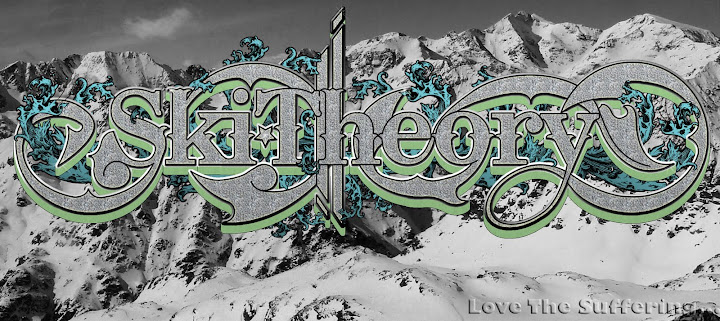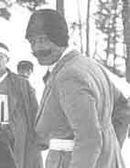A lot of people think Ski Mountaineering Racing is a fairly new sport, but just because you may not have seen it on TV on the highlight reel everyday, doesn't mean it doesn't have deep routes. Ski Mountaineering Racing dates way back to the 1920's and 1930's. Since the 1850's people have been pushing themselves on skis in the mountains, and when people find challenges and begin to overcome them, competition quickly evolves as more people get into the sport and thus Skimo Racing surfaced in around 1910-1915 in small military circles. (Photo Below: Military Patrol Shooting Component)
The military used Skimo Racing primarily as a training opportunity, to ensure a strong group of soldiers would be able to patrol the high mountains passes quickly and efficiently to help protect the people, and fell under the guise of "Military Patrols" hence the names of such large races such as the Patrouilles Des Glaciers in Switzerland (Glaciers Patrol). As these races were usually military exercises, they were run much like the Biathlon in Cross Country skiing, with shooting involved in specific areas and transitions. Now predating these in the late 1770's, Norwegian's held these Patrol races, however they were based with cross country skiing mostly until they evolved and were discovered by countries with high mountains that required a military presence. These Patrols were even popular enough, and were recognized for the amount of skill and fitness required, to make it into the 1924 Winter Olympic Games in Chamonix, France. (Photo Below: Athletes Ceremony and Swearing In, Chamonix 1924)
As great as it was to have Ski Mountaineering Racing in Chamonix's Olympic Games, it was only designated as a demonstration event, but continued throughout the 1924, 1928, 1936, and 1948 games. The Chamonix Race was run as a four man Teams race, with Czechoslovakia, France, Italy, Poland, Finland, and Switzerland competing. In the end, Switzerland took the gold, with Finland in second, France in third, Italy in fourth, and the other Teams withdrawing due to poor conditions and weather. The course itself was 30km in distance and approx 500-1200m of elevation gain. There was a stop halfway through the race to take 18 shots at a target 250m away, with a 30 second penalty if the target was missed and if hit 30 seconds deducted as a reward from their overall ski time.
With the military having fun, and spectators loving the sport, it was time for citizens and the public to begin trying their hand at the sport. In the 1920's civilians began organizing their first few races. The more popular races were in Gosau, Austria - the Mairennen (May Race), and the Geierlauf (Vulture Run) in Wattentaler Lizum Austria. Wattentaler Lizum, remains a military training area that focuses on skimo training and snow exercises for the military today, and two camps sit at 1410m and 1995m respectively. There were more races popping up all over Europe, and more people taking up the sport.
In the 1930's racing really began to take off. In 1933 a group of friends who wanted to remember and celebrate a fallen comrade organized the Trofeo Mezzalama race, in memory of Ottorino Mezzalama (Photo Left: wikideep). It ran from 1933 to 1938 and was designated as a Men's Race, until 1935 when Paula Wiesinger took over for Guisto Gervasutti, wearing his uniform, until she was discovered at a transition and checkpoint mid race. The 1935 race was even filmed, and titled "Maratona Bianca" or "White Marathon." The race orginizing slowed from 1938 on, with the local Ski Club Torino running it in 1940 under a different name the Marcia Nazionale Ottorino Mezzalama. It was not until 1971 until it resurfaced, and run intermittently through 1973, 1975, and again in 1978, but finally run regularly every other year in 1997. (Video Below: In Italian, but footage from the 1935 race)
It was in 1975, at the Trofeo Mezzalama, where the first Ski Mountaineering World Championships occured. 33 Civilian Teams competed alongside 12 Mountain Guide Teams and 11 Military Teams. 1975 was also the first time a Female Team competed officially. (Photo Below: Mezzalama Racers Today, courtesy of ferrino.it)
Beside the Trofeo Mezzalama, another famous race began to come into play, as the Mezzalama took it's break. The Patrouilles Des Glaciers, another originally military run race, was started in April 1943 to test the abilities of Switzerlands soldiers. 18 Teams of 3 competed that year, with a large jump in popularity 44 Teams of 3 raced in 1944. Sadly, the race was put on hold due to World War II, but was restarted soon after on April 10th, 1949 and from their on continued its struggle to survive. During the race in 1949, a Team from a small town in Switzerland skied into a crevasse and lost their lives while racing, forcing the Federal Military Departmentto ban the race until 1984. Now running bi-annually (every 2 years), the Patrouilles Des Glaciers remains under Military Control, but is open to all racers and not just the Military.
Alongside these two large giant races is the crowning jewel of Ski Mountaineering Racing, Pierra Menta. It was started in 1985, and designed as a four day stage race with 10,000m of elevation gain during the four days. Pierra Menta, along with the Patrouilles Des Glaciers and the Trofeo Mezzalama are combined into the "Grand Three" races, and are the most popular and renowned races out there to this day.
Alongside all these races, there are literally hundreds more, from Night Races at local ski clubs, to larger hard courses such as the Dachstein Extreme. From 1990 onwards, racing really saw it's largest increase with small events starting locally, and ski clubs building stronger athletes. Athletes who benefited from these smaller races and ski clubs are now elite members of National Teams and are out dominating the World Cup today. However, now independant races are now offering large and high end awards for the winners, which has become not only an incentive to build and train stronger athletes, but has also begun to split the sport.
On one side racers competing in the World Cup are competing for their countries, still having some difficulty getting by and affording to race professionally or semi-professionally, and others who may have the speed to dominate the World Cup circuit but are interested in the prize bursaries to sustain themselves financially. This growth mimics that of Running Races, Adventure Races, and Triathlon/Ironman in that with a growing field of athletes and races, a divide and personal adjenda greatly affects which athletes will compete where.
Races continue to pop up everywhere, from China, Japan, South America, New Zealand, and of course North America. North America's Ski Mountaineering Circuit is growing extremely quickly, especially with large classic races being organized such as the 5 Peaks race and the Power Of Four race in Colorado. And why not, to see the growth of the sport with heavy old gear in the 1920's in Europe, the same is going on today but with ultra light and beautifully engineered gear. People are excited to get out, push themselves, and see how fast they can go in the mountains.
12 April, 2011
Subscribe to:
Post Comments (Atom)










No comments:
Post a Comment